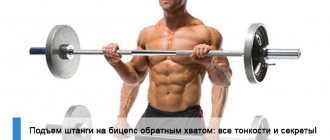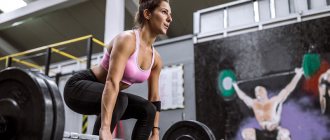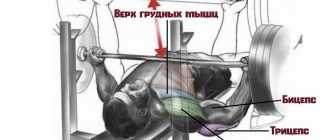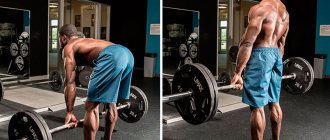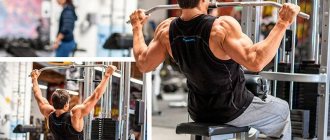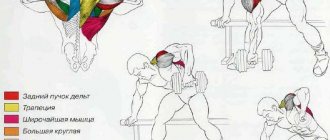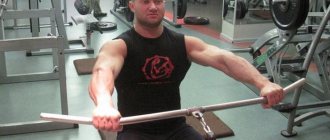Technique for rowing dumbbells to the chin with a wide grip
This option, thanks to the wide position of the arms, resembles raising dumbbells to the sides. An important point is the location of the elbow joints at the top point. At this moment, the elbow joints should be higher than the hands.
The movement starts from the bottom. Palms with dumbbells are shoulder-width apart. The upward movement is performed with exhalation due to the tension of the deltoid muscles
It is very important to exclude jerks and sudden movements from the technique. At the top of the dumbbell row, pause briefly and then slowly lower the dumbbells down
When pulling with a wide grip, the load is concentrated in the middle bundles of the deltoid muscles. Of course, it is impossible to exclude the work of the anterior bundles, like the rhomboid muscles and biceps.
Types of exercise
There are two types of chin pulls - narrow and wide grip. There is a fundamental difference between them: the movement occurs in different trajectories, because of this the emphasis of the load shifts.
Wide grip row
The wide grip option is a more classic variation. It works great on the middle deltoid muscles. Due to the wide stance of the arms, the movement is anatomically reminiscent of swinging dumbbells to the sides - at the top point the elbow is higher than the hand. Often this exercise is performed with incomplete amplitude, without fully extending the arms at the lowest point. Due to this, the muscles do not have time to relax and “switch off”; the feeling of a tearing pump comes much faster.
Close Grip Row
With a barbell row to the chin with a narrow grip, the story is a little different. Here it is uncomfortable for us to keep our arms parallel to the body and we bring them a little forward. Because of this, the load is more accentuated in the front deltas. Also in the movement, the trapezius muscles are strongly involved, with them the athlete reaches the barbell to the very end in the upper amplitude of movement.
In both variations, the biceps and forearms are also included in the work. This happens because it is impossible to hold a heavy barbell without straining your arms. Therefore, there is no need to chase the scales here; it is much more important for us to feel how the target muscle group works, and not to please our ego. The use of wrist straps is also allowed.
Stabilizers in movement are the spinal extensors and abdominal muscles. Due to them we keep the body in an upright position.
Errors in barbell rows to the chin
• the beginning of the movement is carried out due to a jerk with the hands;
• the lifting of the bar occurs due to a squat and toss with the legs; as a result, the initial movement of the bar is given not by the force of the deltas, but
legs;
• the back hunches and leans forward under the weight;
• the grip is much narrower than the shoulders, as a rule, in this position the shoulders are forced to move forward, which will reduce the movement from bottom to top + the elbows experience serious stress.
• lifting the barbell from the floor, it is better to take it from the racks on which it is installed at waist level.
• very fast pace of performing the barbell movement from bottom to top, all movements should be slow, controlled, with a feeling of the muscle.
• sharply lowering the barbell down, the movement in time should be equal both when lifting and when lowering, you can’t do this? It means the weight is too high, reduce it.
Correct technique and types of chin pulls
Despite its apparent simplicity, pulling is considered a complex exercise from a technical point of view.
Therefore, for both beginners and advanced athletes, I first recommend working on technique. Only after this can you begin to make steady progress by increasing the weight on the barbell or machine.
The correct technique for rowing a barbell to the chin is as follows:
- Go to the rack or lower block of the machine and grab the bar with a wide grip. The back should be straight, the legs should be slightly narrower than shoulder level.
- Slowly and without jerking, begin to lift the barbell so that it slides along the body (the touch should be soft, without creating unnecessary resistance from clothing).
- Raise the bar until your triceps are parallel to the floor.
- Make a minimal delay and return the weight to the starting position.
I emphasize that at the peak point the elbow should not be higher than shoulder level, otherwise the main load will fall on the trapezius. A slight tilt of the body forward is allowed if the stretching is anatomically difficult. In this case, the bar can be moved slightly in front of you, compensating for the change with the position of the body. This will allow you to lift the barbell up more naturally. This trick can often be seen in videos of professional athletes, where they demonstrate their deltoids training.
Frequent and common mistakes
When performing the exercise, it is important to follow a number of rules that will help not only get the maximum result from it, but also avoid various types of injuries. Let's look at them in more detail:
- Bringing the barbell to your chin. Don't take the exercise too literally. There is no need to pull the weight exactly to this level. After passing the chest, the forearms will be included in the work. In addition, each trainee has his own range of motion. To determine it, you need to feel the muscles well. But, as a rule, for most the highest point is the level of the chest or collarbone. This is the place you need to pull towards.
- Using too much weight. The biomechanics of the movement is that when lifting the weight upward, the scapula puts pressure on the capsule of the shoulder joint. When working with heavy weight, the shoulder cuff may fail and become injured. As a result, the trainee will be limited to exercises for the deltoid muscles.
- Neglecting warm-up. Although the exercise is performed in the middle of the workout, it is still necessary to perform 1-2 warm-up approaches so as not to injure the shoulder joint. Due to his mobility, he is most susceptible to injury. Therefore, you shouldn’t be lazy, spend a little time and not immediately reach your working weight.
- Properly include in the training plan. Some people are one of the first to start doing this exercise, thereby spending too much effort and energy on it. By the time the trainee moves on to basic presses, the muscles will already be slightly tired and the effectiveness of such exercises will decrease. Therefore, it is more advisable to perform chin pulls in the middle or towards the end of the workout.
- Violation of performance technique. The problem is that many people move the bar away from the body. Because of this, the load falls on the hands. However, the correct thing to do is to keep it as close to the body as possible so that it slides over it. Only then will the shoulders take part in the work, and not other muscles.
- Incorrect body position. In all exercises with a vertical load, the back should be straight. This takes the load off her and does not injure the vertebrae.
- Eversion of the hands. Try to keep your hands straight, otherwise this increases the load of the weight of the barbell on them. As a result, this may interfere with concentration while performing the exercise.
- Don't cheat with your body and arms. This is not an exercise in which you need to “finish off” the remaining repetitions with all your might. Because it's absolutely useless. It’s better to take less weight, but do everything as technically as possible.
- Use dumbbells. They allow you to increase the amplitude, in addition, they are considered a more “gentle” option for the shoulder joint.
What are the contraindications?
The exercise is not recommended in the following cases:
- Pain in the joints of the shoulder, elbows or wrists.
- Neck pain.
- Discomfort in the back or lower back.
Interesting Facts
Bodybuilder Ken Jimmson is a little-known personality in the world of bodybuilding. Until the early 80s of the last century, this athlete was known even less - insofar as he was not among the leaders in competitions. He had excellent herringbone (well engraved psoas muscles), massive shoulders and well-defined arm and leg muscles. The Ken's deltas were insufficiently relief.
In 1982, he unpleasantly surprised his rivals by presenting well-defined deltas to the attention of the audience. The shoulders were maximally developed and with very good relief. He took second place. Giving an interview to a journalist, Jimmson admitted with a laugh that the exercise through which he once “expanded” them—standing deadlifts—helped him achieve such stunning relief of the deltas.
Author of the article: Shalukhin Alexander Alexandrovich
Personal trainer, pharmacologist, nutritionist Creates and conducts personal training programs for body correction. Specializes in sports traumatology and physiotherapy. Conducts classical medical and sports massage sessions.
Comments for the site Cackl e
Standing dumbbell row to the chin, high row for deltoids
The standing dumbbell row to the chin exercise is also called a high row. The high row powerfully develops the lateral deltoids and upper trapezius muscles. The mechanics of the exercise allow you to use quite a significant weight on dumbbells, as well as various intensive training techniques (see below about cheating).
Technique for dumbbell rows to the chin (high row)
At the same time, pull the dumbbells up to chin level, bending your elbows. The dumbbells should move as close to your body as possible and almost strictly vertically.
Throughout the movement, try to keep your elbows higher than your hands.
Essentially, you should be doing lateral and upward elbow raises, using the strength of your trapezius and deltoids, with your forearms just hanging down.
Having raised the dumbbells to the desired level, hold them in this position for a moment, and then smoothly lower them, performing the opposite movement. Immediately pull them up again, don't hold them down for a second. Complete the required number of repetitions.
Dumbbell row to the chin. Finish.
Dumbbell row to the chin. Initial position.
Dumbbell row to the chin. Finish.
Please note: try to choose a weight of dumbbells so that you do not have to help yourself by swinging your body. The torso must remain motionless
In addition, do not rush to use heavy weights of dumbbells, since high rows with dumbbells require the development of technique and precision of movements.
If you are experienced, you can use significant weight using the cheating technique. Then the dumbbell row to the chin will turn into a snatch row.
The exercise trains not only the trapezius muscles, but also the lateral deltoids, anterior deltoids, biceps, and forearm muscles.
The back extensors receive static load.
Exercise options
Dumbbell rows to the chin can be done by lifting dumbbells alternately with your left and right hands.
The exercise can also be performed with a barbell, on a cable machine, in a Smith machine, with a rubber expander, or with one dumbbell (if you can comfortably hold it by the ends of the bar).
The dumbbell high row is an exercise that develops the muscles that externally rotate the humerus (supination). Such exercises must be present in any strength program to prevent injuries to the shoulder joints.
Chin pull for girls[edit | edit code]
Chin Row Smith Machine Chin Row
The chin row is a compound exercise because it moves the shoulder, elbow, and wrist joints. As a result, not only the muscles of the shoulder girdle work, but also the upper trapezius muscles, biceps and forearm muscles.
Performance
Stand up straight, holding a barbell, dumbbells or the handle of a cable machine in front of you with an overhand grip. Raise your arms while bending your elbows; keep your palms as close to your body as possible. You can lift the weight to your chin, but many women prefer to lift it only to chest level.
Advantage
- This multi-joint shoulder girdle exercise works more than just the anterior deltoids.
Flaw
- Some women injure their shoulders and/or wrists during the rotational movement. If this is your case, replace the chin pull with lateral raises.
Don't raise your arms too high. Reduce your range of motion and stop before your upper arms are parallel to the floor because:
- The higher you raise your arms, the more actively the upper trapezius muscles are involved and the less the deltoids are involved in the movement.
- When you raise your arms too high, your shoulder joints rotate in an undesirable way. When your palms reach chest level, your shoulder joints will begin to rotate slightly. If you raise your arms above this point, your shoulder joints rotate more and more. When the tops of the arms are parallel to the floor, the joints are in extreme positions.
- The higher you raise your arms, the more stress you put on your wrists (you have to hold the barbell).
Benefits of Barbell Chin Rows
- Balancing the weight is easier than with dumbbells.
Lack of barbell chin pull
- The straight bar causes many women to rotate their wrists in an unnatural way, increasing the risk of joint injury. The higher you lift the bar, the more you have to rotate your wrists. A curved bar (EZ bar) will help minimize this inconvenience.
Benefits of the Smith Machine Chin Row
- Since there is no need to balance the weight, this option is suitable for beginners.
Lack of chin pull on the Smith machine
- The arms are even less free to move than in the case of the barbell option, which increases the risk of injuries to the wrist joints.
FREE WEIGHTS OR MACHINES?
Since there are very few special machines for chin rows, in the classic case this exercise is performed with a barbell, dumbbells, on a Smith machine or a cable machine. All these options give approximately the same muscle effect, differing only in the load on the joints.
Benefits of Dumbbell Chin Rows
- Your arms move completely freely, which minimizes the chance of unnatural wrist rotation and allows you to rotate your arms to better engage your middle deltoids.
Lack of chin pull with dumbbells
- Since both arms have complete freedom of movement, it is quite difficult to balance the weight, which may be difficult for beginners. However, women usually quickly learn to control the movement so that they can raise both arms at the same time.
Benefits of Cable Pulldowns
- Exercise on a cable machine installed in the lower position causes much less injury to the shoulder joints than the option with free weights.
- By performing this exercise while lying on the floor, you significantly reduce the load on your spine. If you are experiencing lower back pain, but still want to work out the muscles of the shoulder girdle, this option is right for you. In any case, do not arch your lower back. Keep it pressed to the floor throughout the exercise.
Lack of chin pull on the cable machine
- Using a straight bar, you face the same problems as with the barbell version. If possible, use a figured bar (EZ bar).
Recommendations[edit | edit code]
Recommendations for performing exercises
- If you feel like your trapezius muscles are working too hard, it's best to opt for a one-arm, dumbbell, or cable machine lift. In other cases, it is better to lift both arms at the same time as it saves time.
- To use the deltoids rather than the trapezius muscles, you need to position your hands correctly. In general, consider the following rules:
- * The wider the grip, the less the trapezius muscles are involved.
- * The higher you lift the barbell, dumbbells or the handle of a cable machine, the more active the trapezius muscles work.
- Arching your back may allow you to lift heavier weights, but it increases the likelihood of spinal injuries.
Benefits of exercise
This exercise is called the barbell pull behind your back, otherwise known as the Lee Haney deadlift. It is this legendary athlete from the world of bodybuilding that is considered the “inventor” of the exercise in question.
What is noteworthy is that the barbell row behind the back serves not only to satisfy the aesthetic requirements of bodybuilding judges. The fact is that the muscles related to the interscapular space are often hypotrophied in people leading a sedentary lifestyle. Also, the middle of the back is chronically disabled in representatives of certain professions - jewelers, violinists, accountants, programmers. This leads to impaired blood circulation in this area, and therefore to impaired blood supply to the thoracic spine.
In addition, the middle and lower portions of the trapezius, together with the posterior delta, biomechanically “align” the upper shoulder girdle relative to the distribution of the latter’s weight across the chest. What does it mean? When the above muscle complex is weakened, the shoulder joints move forward, under the influence of traction from the pectoralis minor and major muscles.
It would seem, what’s so terrible? With this position of the body, the weight of the upper shoulder girdle falls on the 7th cervical vertebra, and this inevitably entails hyperlordosis of the cervical spine. This disease is the cause of acute headaches, deterioration of visual acuity, and chronic headaches.
And it is precisely in order to prevent these conditions that we must develop the muscles of the interscapular space. The easiest way to do this is by pulling a barbell behind your back while standing.
Runtime errors
To ensure that the exercise has maximum effect and does not damage joints and ligaments, pay attention to the common mistakes that occur when performing it. This will help you control your movements and work on muscle development without the risk of injury:
- Do not raise your elbows forward when lifting the dumbbells. This is a traumatic position for the shoulder joints. The elbows move to the sides in a vertical plane.
- Keep your body stable throughout the movement, do not bend your neck or arch your back. Any deviations in body position from the correct one remove the load from the target muscles.
- Don't use too much weight, which will cause you to break your form. This will not give the desired effect, it will only waste your time.
The dumbbell row to the chin is more gentle on the joints than the same exercise with a barbell. By performing it in combination with other exercises, you can get a beautiful outline of the muscles of the shoulder girdle, increase their volume and develop strength.
Advantages and disadvantages of pulling dumbbells to the chin
- The vertical dumbbell row seems like a simple exercise from the side, however, due to the lack of fixation of sports equipment, it is more difficult to perform.
- The exercise allows you to perform rows with one arm alternately, which is a more concentrated movement and relieves possible pain in the shoulder, elbow and wrist joints.
- Also, this type of deadlift can be performed with minimal weights, which is suitable for women and those athletes who are rehabilitating after an injury.
Shoulder exercises with dumbbells
Developed shoulders combined with a thin waist are the athlete’s “triangle” that brings the male figure closer to the ideal of beauty. The volume and mass of the shoulder deltoid muscles can be effectively pumped up by exercising with dumbbells. A huge plus is that you can train at home, the main thing is determination, regularity and adherence to the correct technique. Some of the most popular and give good results include presses, rows to the chin and raises from different positions. Some give strength, others build volume and muscle mass.
Classification of exercises
Shoulder exercises with dumbbells can be grouped into:
- basic, when other muscles are involved in the work in addition to the main one;
- isolated, loading exclusively a specific section of the fibers.
The working muscle group when performing basic presses is as follows:
- Main: deltoid (anterior and middle or lateral heads);
- Additional (synergists): triceps, supraspinatus, trapezius (middle and lower lobes), clavicular head of the pectoralis major muscle, serratus anterior.
- Stabilizers: upper trapezius, levator scapula.
- Movement stabilizers: biceps, long head of triceps.
During swing movements, the load is isolated, only one muscle is under control. It is the main and only one - the deltoid, its anterior, middle or posterior bundles. Other muscles should be turned off from work.
Standing Dumbbell Press
- I.P. Vertical stance, feet shoulder-width apart. Raise your hands with dumbbells to eye level, turn them to the sides. Palms facing away from you. The angle between the shoulder and forearm is 90°.
- As you exhale, forcefully lift the dumbbells above your head and squeeze them slightly at the top point. Do not straighten your arms completely, do not make jerks. Hold for 1-2 seconds. Do not tilt your back back, do not bend your lower back.
- As you inhale, smoothly lower the dumbbells to IP. When raising your arms, make sure that your elbows do not drop low. The shoulder line should be parallel to the floor. Otherwise, the shoulder joint will be under stress.
- Without delay, start a new press.
Seated dumbbell press
This is a more isolating variation of the standing press. While sitting on a bench, there is no opportunity to cheat - jumping up to take on more weight. It is recommended to set the backrest angle to 80-90°.
- I.P. The position of the hands with dumbbells is similar to the standing press. There is a slight deflection in the lower back, the knees are apart, the feet rest on the floor.
- The technique of execution is no different from that described above.
In both variations of the exercise, the arms move in the same plane.
Arnold press (press with wrist rotation)
This particular exercise was popularized by Arnold Schwarzenegger, who, as you know, was very successful in bodybuilding. The front bundle of deltas is targeted. It is now considered a bodybuilding classic.
Recommendations for implementation
As you already understand, the delta muscles work in three planes. Lifting forward and to the sides, as well as pulling back. But there are some more functions.
Shoulder rotation during lifting
If we hold the hand below the elbow when lifting, then the entire load will go to the anterior and middle delta. But once we add external rotation to the movement. That is, when lifting we will twist our shoulder back. Then the rear delta will also connect. And we will be able to immediately influence three heads.
Body tilt
During normal execution, the middle deltoid and slightly the rear deltoid receive more load. That is, we are talking about traction with a flat body. But if we want to turn this exercise into a good tool for forming the rear delt. Then you should lean forward a little. And immediately we will see the difference. Now the arms are raised not to the side, but back. Performing the main functions of the rear deltas.
Body position relative to the projectile
This technique cannot be used with every weight. And it is not used very often, since there are many other exercises for the shoulders. Such as: DUMBBELL SWINGS ON AN INCLINE or SIDEWAY FLOW. And athletes give preference to them. But still, for general development, it will be useful to know. If we get close to the burden. Our movement will occur due to the middle deltas. Since the elbows will diverge to the sides above the body. If we move back a little. Then part of the load will transfer to the front heads. But the main thing here is not to overdo it. After all, if we move too far away, the exercise will turn into swinging in front of us.
Grip width
I have already mentioned this indirectly. With a wide grip, we will lift the weight using the deltoid muscles. Since with such a position of the hands it is more difficult to raise the shoulders up to engage the trapezius. And with a narrow grip, this is easier to do. Therefore, it is used if they want to develop the upper trapezius muscles.
As you can see, this exercise can be used for any need. But for some reason he rarely uses the chin pull now. Giving preference to presses, swings and exercise machines.
Execution technique
Before you start doing the exercise, choose the option that suits you.
Initial position:
- Take the weight of your choice in your hands. If it's a barbell or Smith machine, then place your hands on the bar, choosing the desired grip width. In a block trainer for a narrow grip, a cable handle is usually used. And for a wide one, a long straight handle.
- If you plan to use the deltoids in your work, then you need to lower your shoulders down, thereby stretching the trapezius as much as possible.
Important!
Although the exercise is called a barbell row to the chin, with a wide grip we will not pull it to that level. Basically, the lift occurs to the middle of the pectoral muscles.
Performance:
- After you have taken the starting position, as you exhale, we begin to pull the weight up. At the same time, if we work on deltoids, we must ensure that the elbows do not rise above the level of the cries.
- After a short pause, while inhaling, lower your arms down.
Don't forget that the movement should resemble a deadlift, not a swing. Therefore, choose a weight that provides enough resistance to your muscles.
Narrow grip
For a good “pumping” of the trapezius muscles, it is necessary to include close-grip barbell rows in the training program.
There is an exercise for developing the middle region of the back - barbell rows with a curved bar, narrow grip. It works well on the rhomboid muscles and engages the lower trapezius. But this exercise is ideal when you need to achieve maximum definition in the middle of your back.
To “pump up” the trapezius, pulling to chin level is better suited. To maximally stimulate the trapezius, it is best to perform this exercise after shrugs, in a high number of repetitions, with relatively light weights.
The grip should be slightly narrower than shoulder width. With a very narrow grip, the load from the trapezius and shoulders is shifted to other muscles - the wings, anterior deltoids and biceps. Below is a weekly back workout program that includes chin pulls.
Day 3
- Bent-over barbell row.
- Dumbbell rows (training the middle region of the back).
Chin rows are performed after shrugs because the upper trapezius region is virtually inactive in the deadlift, and shrugs have very little stimulation of the lower trapezius. If you perform shrugs and rows to the chin after deadlifts, the effect of training the deltoids and trapezius increases significantly.
Exercises to pump up the shoulder muscles at home
Pumping up the shoulder muscles with dumbbell swings
Today there are various shoulder exercises at home. There are a very large number of them, but this does not mean that you necessarily need to do them all. In order to pump up the wide muscles quickly enough, you should choose 3-4 most suitable exercises.
Advice! Your training program must include exercises aimed at developing the front, middle and rear deltoids.
Performing overhead presses to pump up the shoulder muscles
Benching the barbell from behind the head allows you to develop the front and side deltoids and triceps. If there is no barbell, we pump our shoulders with dumbbells, performing the same actions.
Advice! Since presses can cause joint injuries, it is best not to perform such exercises first. They should be done when your muscles are properly warmed up.
Performance:
- In a standing or sitting position, grab a barbell (dumbbells) with an overhand grip.
- Your forearms should be parallel to each other.
- Now you need to lower the bar along the trapezoid and linger for a few seconds at the lowest point.
- Slowly lift the barbell up, thereby returning to the starting position.
Advice! When using dumbbells, try to lower them as low as possible.
The lateral and anterior shoulder muscles allow you to develop the military press. This exercise can also be performed either sitting or standing.
Performing a standing military press
Let's look at how to properly perform a military press:
- While standing or sitting, grab a barbell with an overhand grip.
- In the starting position, your elbows should be down and the bar should be at chest level.
- Now we fully straighten our arms, lifting the barbell above our heads. Stay in this position for one second.
- Slowly lower the barbell to the starting position.
This material will be perfectly complemented by the following publications:
Correct performance of dumbbell lateral raises while standing
To develop the middle deltas, it is necessary to raise dumbbells to the sides in a standing position.
Advice! When performing this exercise, you should not swing your body, this will reduce the load directly on the shoulder muscles.
Performance:
- Hold dumbbells in a standing position.
- Extend your arms slightly in front of you, slightly bending them at the elbows.
- Raise your arms to the sides at shoulder level, holding the top position for a second.
Lifting dumbbells in front of you allows you to develop your front deltoids well.
Front dumbbell raises
If you do chest presses, you won't need this exercise. When performing the exercise, you need to take dumbbells in your hands and slightly extend them in front of you, slightly bending your elbows. Now raise your arms above your head one by one.
If you are interested in how to pump up your shoulders at home, then bent over dumbbell raises should be one of the basic exercises for you. To perform it, you need to take dumbbells and then bend your torso at an angle of approximately 45 degrees. We stretch our arms in front of us and spread them to the sides.
Chin Pulls
Performing barbell rows to the chin
Want to know how to pump up your shoulders with dumbbells? Then you will need a barbell. In particular, barbell rows to the chin allow you to develop your trapezius and front deltoids. If you want to pump up your shoulders as much as possible, just increase your grip.
To perform this exercise, you should stand as straight as possible and grasp the barbell in your hands so that your palms face down. Now pull the barbell towards your chin while spreading your elbows out to the sides.
Similar to the previous one is the barbell row to the chest. Only in this case you do not reach the chin, but stop at chest level, slightly lingering at the top point.
Advice! The exercise should be performed with a wide grip.
How to perform a barbell row to the chest: arms at the top point are parallel to the floor
Conclusion
Above we described how to pump up your shoulders at home. Choose 3-4 activities that are most suitable for you from this list and practice regularly. In this case, the results will be noticeable very soon.
Why do this exercise
Let's look at what exercises the barbell row to the chin can repeat. To pump up your shoulders, there are military presses, overhead barbell lifts, various dumbbell flyes, and angled barbell presses. For trapezius - shrugs.
The chin pull combines several exercises. Definitely, it simultaneously contains shrugs and lateral raises of dumbbells. And that's why:
- When we pull the projectile up, the movement is first carried out using the strength of the deltoid muscles (with the correct technique, of course).
- Further movement is carried out by the upper parts of the trapezius muscle.
Thus, different exercise techniques will allow you to concentrate efforts either on the shoulders or involve the upper back in the work.
This exercise must be performed once a week before isolated elements on the shoulders. Shrugs can be done after.
The trapeze element is called a “high barbell row.” On the shoulders - pull the barbell to the chin.
You can also find names such as “standing barbell pull” and “barbell pull.” It is the same. Usually in the gym such words are not used, just like “lifting”.
Execution Variations
- Single dumbbell row. You can pull one dumbbell by the discs with both hands, or one dumbbell alternately. The first option can only be considered by people with narrow shoulders, flexible wrists and suitable strength. Usually these are teenagers and short girls. The second option is preferable for bodybuilding, as it allows you to achieve symmetrical development of the muscles of both halves of the body;
- Rows with dumbbells can also be performed with different arm widths, which allows you to create a load on both the biceps, triceps and shoulders, and practically isolate the shoulder, turning it off from work.
